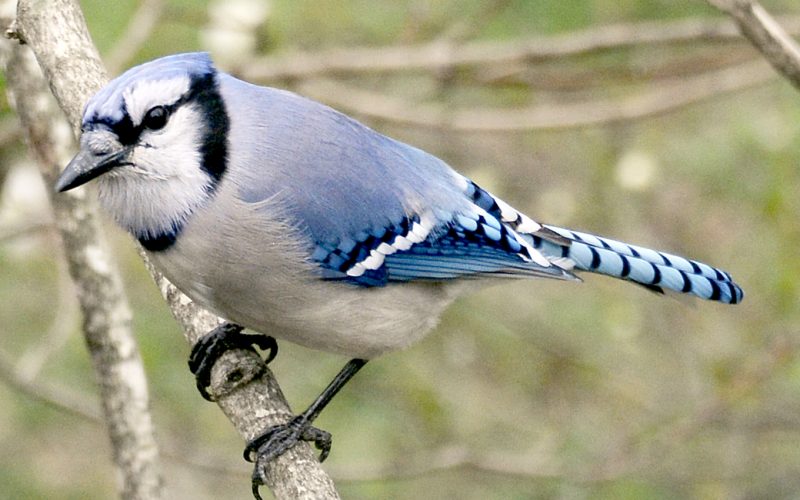
Staff Photo Amanda Bancroft This blue jay perched in a maple tree in Fayetteville looks gorgeously blue, but it’s all a trick of the light: its feathers provide structural color rather than blue pigment.
Blue jays tend to evoke strong opinions. “Ya either love ’um or hate ’um.” In truth, these birds are beautiful, fascinating, and aggressive. A more moderate take on blue jays strikes closer to the truth about them: they are not your typical feeder bird nor are they vicious villains.
According to the book Blue Jays by Wil Mara, the blue jay (Cyanocitta cristata) has four subspecies in North America. These include the northern, coastal, interior and Florida jays, and the interior variety common in Northwest Arkansas may be the most gorgeous of all. With a wingspan of 15-16 inches and weighing 2.5-3.75 ounces, they’re considered medium-sized birds.
Their stunning combination of white, black, and deep blue patterned feathers are not only an optical illusion but also useful in reading the bird’s mood.
Blue jays are not actually blue, they have what’s known as structural color, because their feathers reflect blue wavelengths of light back towards our eyes while absorbing the other wavelengths of light. This makes them appear as though they were literally painted blue, but varies based on how much sunlight is available.
Their blue crests atop their heads are pretty, and tell us about the bird’s temperament: a raised crest signifies agitation or anger, while a lowered crest means the bird is relaxed or calm. Since they’re territorial, it isn’t hard to see a jay with crest erect, and they will vocalize or even mob perceived intruders such as other birds, reptiles, and mammals including humans.
However, their aggressive tendencies don’t tell the whole story of their character. Blue jays typically mate for life, and the male builds most of the nest. Nesting sites are found in a variety of locations and heights. Females lay on average a clutch of 4-5 blueish or tan speckled eggs. They hatch after 2-3 weeks. Doting parents are protective of the nest and very attendant to their offspring’s needs. The gray fluffy nestlings look distinct from the adults and hop about, learning to fly. If they survive to adulthood, jays can live about 6-8 years in the wild!
Our local blue jays are non-migratory, year-round residents and feed on nuts, acorns, seeds, berries, and rarely, other birds’ eggs and nestlings. They also thoroughly enjoy cat food and target that over the offerings of a bird feeder, although this may not be ideal nutrition for a bird. Because they’re diurnal (most active during daytime) and don’t mind the presence of humans, they make excellent birds to watch at feeders or in urban, suburban and rural locations. Next time you see a blue jay, notice the position of its crest and see if you can guess what it’s thinking! An awareness of a bird’s mood can indicate often hidden details of the environment around them.
Amanda Bancroft is a writer, artist, and naturalist building an off-grid earthbag cottage for land conservation on Mt. Kessler. She and her husband Ryan blog about their adventures and offer a solar-hosted online educational center on how to make a difference with lifestyle choices at: www.RipplesBlog.org.










